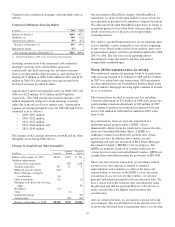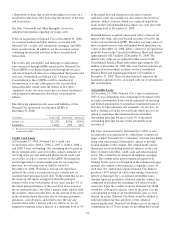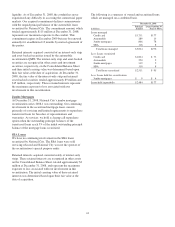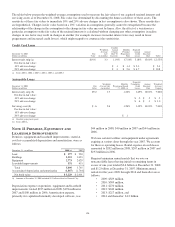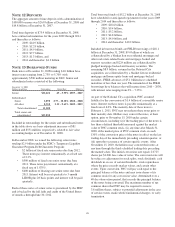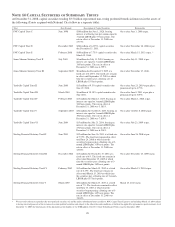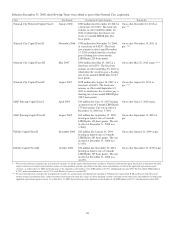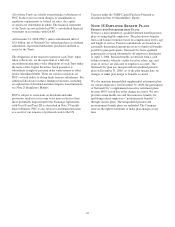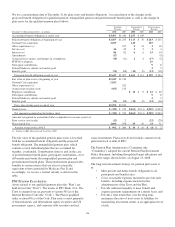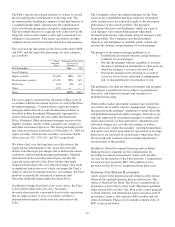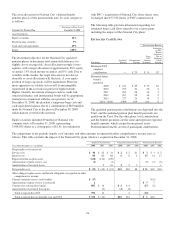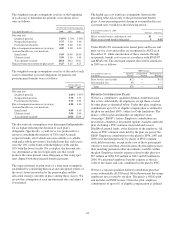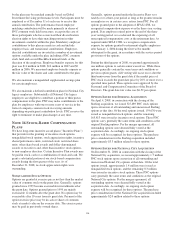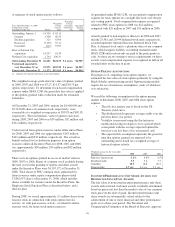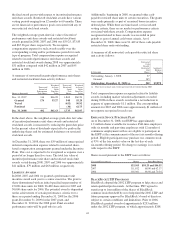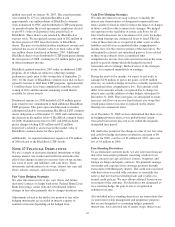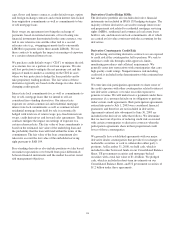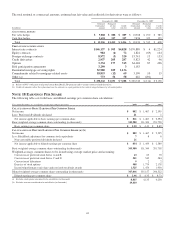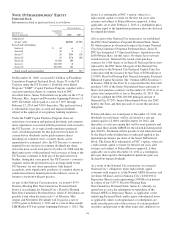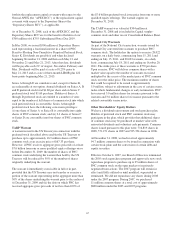PNC Bank 2008 Annual Report Download - page 131
Download and view the complete annual report
Please find page 131 of the 2008 PNC Bank annual report below. You can navigate through the pages in the report by either clicking on the pages listed below, or by using the keyword search tool below to find specific information within the annual report.
The Plan’s specific investment objective is to meet or exceed
the investment policy benchmark over the long term. The
investment policy benchmark compares actual performance to
a weighted market index, and measures the contribution of
active investment management and policy implementation.
This investment objective is expected to be achieved over the
long term (one or more market cycles) and is measured over
rolling five-year periods. Total return calculations are time-
weighted and are net of investment-related fees and expenses.
The asset strategy allocations for the Trust at the end of 2008
and 2007, and the target allocation range, by asset category,
are as follows:
Target
Allocation
Range
Percentage of Plan Assets
by Strategy at
December 31
PNC Pension Plan 2008 2007
Asset Category
Equity securities 49-69% 58% 62%
Fixed income securities 32-39% 39% 34%
Real estate 4-6% 3% 4%
Other 0-5% ——
Total 100% 100%
The asset category represents the allocation of Plan assets in
accordance with the investment objective of each of the Plan’s
investment managers. Certain domestic equity investment
managers utilize derivatives and fixed income securities as
described in their Investment Management Agreements to
achieve their investment objective under the Investment
Policy Statement. Other investment managers may invest in
eligible securities outside of their assigned asset category to
meet their investment objectives. The actual percentage of the
fair value of total plan assets held as of December 31, 2008 for
equity securities, fixed income securities, real estate and all
other assets are 32%, 55%, 0%, and 13%, respectively.
We believe that, over the long term, asset allocation is the
single greatest determinant of risk. Asset allocation will
deviate from the target percentages due to market movement,
cash flows, and investment manager performance. Material
deviations from the asset allocation targets can alter the
expected return and risk of the Trust. On the other hand,
frequent rebalancing to the asset allocation targets may result
in significant transaction costs, which can impair the Trust’s
ability to meet its investment objective. Accordingly, the Trust
portfolio is periodically rebalanced to maintain asset
allocation within the target ranges described above.
In addition to being diversified across asset classes, the Trust
is diversified within each asset class. Secondary
diversification provides a reasonable basis for the expectation
that no single security or class of securities will have a
disproportionate impact on the total risk and return of the
Trust.
The Committee selects investment managers for the Trust
based on the contributions that their respective investment
styles and processes are expected to make to the investment
performance of the overall portfolio. The managers’
Investment Objectives and Guidelines, which are a part of
each manager’s Investment Management Agreement,
document performance expectations and each manager’s role
in the portfolio. The Committee uses the Investment
Objectives and Guidelines to establish, guide, control and
measure the strategy and performance for each manager.
The purpose of investment manager guidelines is to:
• Establish the investment objective and performance
standards for each manager,
• Provide the manager with the capability to evaluate
the risks of all financial instruments or other assets in
which the manager’s account is invested, and
• Prevent the manager from exposing its account to
excessive levels of risk, undesired or inappropriate
risk, or disproportionate concentration of risk.
The guidelines also indicate which investments and strategies
the manager is permitted to use to achieve its performance
objectives, and which investments and strategies it is
prohibited from using.
Where public market investment strategies may include the
use of derivatives and/or currency management, language is
incorporated in the managers’ guidelines to define allowable
and prohibited transactions and/or strategies. Derivatives are
typically employed by investment managers to modify risk/
return characteristics of their portfolio(s), implement asset
allocation changes in a cost-effective manner, or reduce
transaction costs. Under the managers’ investment guidelines,
derivatives may not be used solely for speculation or leverage.
Derivatives are used only in circumstances where they offer
the most efficient economic means of improving the risk/
reward profile of the portfolio.
BlackRock, Global Investment Servicing and our Retail
Banking business segments receive compensation for
providing investment management, trustee and custodial
services for the majority of the Trust portfolio. Compensation
for such services is paid by PNC. Non-affiliate service
providers for the Trust are compensated from plan assets.
N
ATIONAL
C
ITY
P
ENSION
P
LAN
A
SSETS
Assets related to the pension plan investments of the former
National City qualified pension plan are held in trust. The
trustee is National City Bank. The Trust is exempt from tax
pursuant to section 501(a) of the Code. The plan is qualified
under section 401(a) of the Code. Plan assets consist primarily
of listed domestic and international equity securities and US
government, agency, and corporate debt securities and real
estate investments. Plan assets do include common stock of
PNC as discussed below.
127


